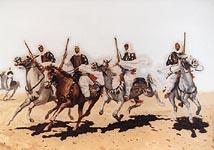 |
Keys
to the Kingdom National Anthem The Office History |
|
Much of the trauma and dislocation suffered by the peoples of the Middle East during the 20th century can be traced to the events surrounding World War I. During the conflict, the Ottoman Empire sided with the Central Powers against the Allies. Seeing an opportunity to liberate Arab lands from Turkish oppression, and trusting the honor of British officials who promised their support for a unified kingdom for the Arab lands, Sharif Hussein bin Ali, Emir of Mecca and King of the Arabs (and great grandfather of King Hussein), launched the Great Arab Revolt. After the conclusion of the war, however, the victors reneged on their promises to the Arabs, carving from the dismembered Ottoman lands a patchwork system of mandates and protectorates. While the colonial powers denied the Arabs their promised single unified Arab state, it is nevertheless testimony to the effectiveness of the Great Arab Revolt that the Hashemite family was able to secure Arab rule over Transjordan, Iraq and Arabia. |
|
In order to discern the motives of the Hashemites in undertaking the revolt, one must understand the policies undertaken by the Ottoman Empire in the years leading up to World War I. Following the Young Turk coup of 1908, the Ottomans abandoned their pluralistic and pan-Islamic policies, instead pursuing a policy of secular Turkish nationalism. The formerly cosmopolitan and tolerant Ottoman Empire began overtly discriminating against its non-Turkish inhabitants. Arabs in particular were faced with political, cultural and linguistic persecution. During this time, Arab nationalist groups in Syria, Iraq and Arabia began to rally behind the Hashemite banner of Abdullah and Faisal, sons of Sharif Hussein bin Ali, King of the Arabs. When the Ottomans entered World War I on the side of the Central Powers in 1914, they upheld the ban on the official use of the Arabic language and its teaching in schools, while arresting many Arab nationalist figures in Damascus and Beirut. Arabs were further threatened by the construction of the Hijaz Railway, connecting Damascus and Mecca, which promised to facilitate the mobility of Turkish troops into the Arab heartland. Consequently, in June 1916, as head of the Arab nationalists and in alliance with Britain and France, Sharif Hussein initiated the Great Arab Revolt against Ottoman rule. His sons, the emirs Abdullah and Faisal, led the Arab forces, with Emir Faisal’s forces liberating Damascus from Ottoman rule in 1918. At the end of the war, Arab forces controlled all of modern Jordan, most of the Arabian peninsula and much of southern Syria. Sharif Hussein’s objective in undertaking the Great Arab Revolt was to establish a single independent and unified Arab state stretching from Aleppo (Syria) to Aden (Yemen), based on the ancient traditions and culture of the Arab people, the upholding of Islamic ideals and the full protection and inclusion of ethnic and religious minorities. Arab nationalists in the Fertile Crescent and the Arabian Peninsula found in the Hashemite commanders of the Great Arab Revolt the leadership that could realize their aspirations, and thus coalesced around them. |
 The Great Arab Revolt, Wadi Rum, 1917. © Royal Hashemite Court Archives |
|